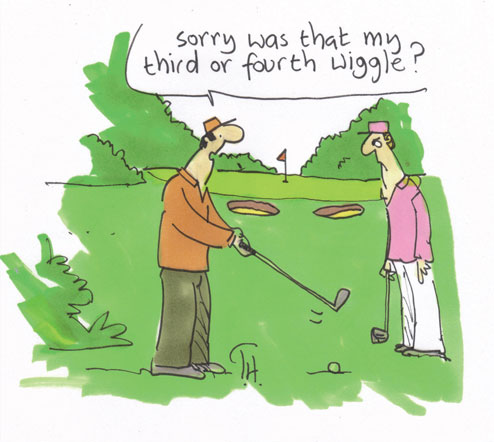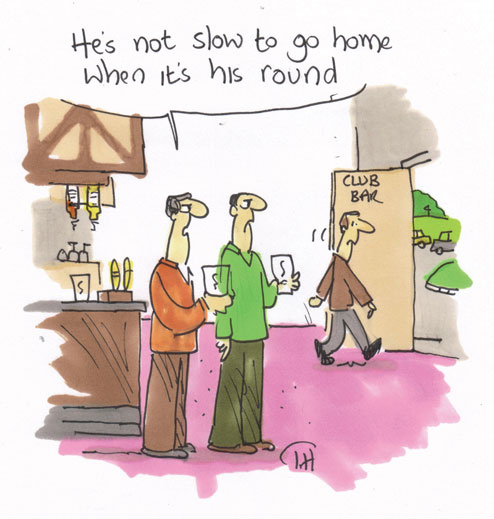The War On Slow Play
At some time during their playing career I am sure most golfers will have both caused and suffered from the scourge of slow play out on the course. With this in mind Rico Liverani has been looking into ways to assist with managing slow play out on the course. To start the ball rolling the following hints and tips try to show us the right and wrong way to play the game we all love -
On The Tee

The Wrong Way
• The slow player will not approach the teeing ground until it is completely clear of other players. The initial approach will be made without a club or ball in order for the player to ascertain the direction and distance of the next hole. The slow player may then return to his bag to select the required club and a ball.
• After teeing-up, the slow player must retreat at least ten yards, keeping the ball and the intended target in line, and consider the shot for an appropriate length of time. He may then select another club or put on his glove, or do both of these things, before addressing the ball for the first time. A slow player may step back from the address no more than three times.
• A slow player may have no more than six practice swings and five jiggles before the final address, which must last at least 20 seconds before the stroke is made. The slow player must retain his position on the teeing ground for at least 10 seconds after the ball has come to rest.
PENALTY FOR BREACH OF ANY OF THE ABOVE
For the slow player – NONE ...... For the following groups – a feeling that it's going to be a LONG round.
The Correct Way
• When on the tee, pay attention to your partners' drives. If they lose sight of their ball, you can help direct them to it and avoid any time lost searching.
• When waiting on the tee for the group in front to clear the fairway, don't be so strict about order of play. So long as it is safe to do so let the short hitter - who can't reach the group ahead anyway - go ahead and hit.
• When teeing off carry extra tees, ball markers and an extra golf ball so you never have to return to your golf bag to find one when needed.
On The Fairway
The Wrong Way
• A measured pace is to be maintained, but never directly towards where the ball has come to rest. Should a partner be required to play first, the slow player must never walk forward of him regardless of whether his ball is in line of play or not.
• Once within ten yards of his ball, the slow player will reduce his pace appreciably before circling his ball in order to examine the ground around it. At no time during the walk will the slow player consider which club to use next or acknowledge the presence of anyone else playing with or behind him.
• On returning to his bag after finally playing his shot, the slow player will return the club to the correct slot in no more than three attempts. All clubs, including irons, will have head covers which require careful replacement. Before moving on, the player will remove his glove, adjust his clothing and consult his scorecard.
PENALTY FOR BREACH OF ANY OF THE ABOVE
For the slow player – NONE ...... For the following groups – at least two shots dropped through rising exasperation.
The Correct Way
• Members of a group should not travel as a pack, with all members walking together to the first ball, then the second, and so on. Each member of the group should walk directly to his own ball. Use the time you spend getting to your ball to think about the next shot - the yardage, the club selection. When you reach your ball you'll need less time to figure out the shot.
• Walk at a good pace between shots. No, you don't have to look like a race-walker. But if your between-shot gait can be described as a "shuffle" or an "amble," you're probably going too slow. Speeding up your gait a little is good for your health, but also might help your game by keeping you loose.
• Work on building a concise pre-shot routine. If your pre-shot routine is a lengthy one, it's probably in your best interests to shorten it anyway. Limit practice strokes to one or two at the most.
• When two players are riding in a cart, drive the cart to the first ball and drop off the first player with his choice of clubs. The second player should proceed in the cart to his ball. After the first player hits his stroke, he should begin walking toward the cart as the second golfer is playing.
• Never delay making a stroke because you're having a conversation with a playing partner. Put the conversation on hold, make your stroke, then pick up the conversation again.
• If using a cart on a cart-path-only day, take more than one club with you when you walk from the cart to your ball. Getting to the ball only to find out you don't have the right club is a huge time-waster on the golf course.
Searching For Lost Balls
The Wrong Way
• When searching for a lost ball, the slow player must:
(a). Never take his bag to within 50 yards of the search area.
(b). Never carry a suitable iron or two that may be used when the ball is found.
(c). Always search assiduously for a ball in stableford competitions even when he is already three over handicap par for that hole and hence unable to score.
PENALTY FOR BREACH OF ANY OF THE ABOVE
For the slow player – NONE ...... For the following groups (now two groups of fourballs) – some shared blaspheming and an increase in the floridity of the complexion of any retired major.
The Correct Way
• If you are unsure whether your ball has come to rest out of bounds, or may be lost, immediately hit a provisional ball so that you won't have to return to the spot to replay the shot. If you do loose a ball our Society Rules allow you to simply drop a new ball in the where your ball was lost and keep playing (taking a TWO STROKE penalty, of course). If you are searching for a lost ball and intend to spend a few minutes looking for it, always allow the group behind to play through.
• Don't ask your playing partners to help you search for a lost ball - unless they have located their own and you are absolutely certain there is time for them to do so (e.g., there is no group behind waiting). If the course is crowded, your partners should continue moving forward, not slow things down further by stopping to help your search.
On The Green
The Wrong Way
• When approaching the putting green, the slow player will ascertain the route to the next hole and position his bag/trolley on the opposite side of the green to it. He will then approach his ball on a circuitous route from beyond the flag, at times stooping or moving backwards or sideways to establish the contours of the green from all angles, except of course that of his line of putt, taking care to remove all loose impediments anywhere on the green.
• On reaching his ball, he will mark it carefully and take it to his bag to clean. The cleaning process will not start until it is his turn to putt. After cleaning, he will replace his ball so that the maker's name, or any self-inscribed mark, is lined up exactly on the calculated putting line. This may be adjusted no more than four times. The slow player will then enter the final phase of lining up. This must include:
(a). Calculating the line from the other side of the pin, from both sides and again from behind the ball.
(b). Kneeling or crouching using the putter as a plumb-line or as a prop, preferably on someone else's line.
(c). Removing the pin to gaze into the hole.
(d). Marking his ball carefully before adjusting its line following the second deliberation.
(e). Retreating to the edge of the green to ask his partners if it is his turn.
• The putt and sequential actions
(a). Unless a putt is holed, the slow player must not follow the ball immediately. Instead he may check the line and practice his stroke a minimum of three times before marking his ball and lining up again until such time as the putt is holed. In a friendly, it is essential to hole out even though the putt is given.
(b). Before leaving the green, two more practice putts are permitted to ensure the line is noted for future play. The score should be registered before moving to the player's bag/trolley and the scorecard checked while ambling along the front of the green to the next hole.
PENALTY FOR BREACH OF ANY OF THE ABOVE
For the slow player – NONE ...... For the following groups (now four) – two broken clubs, a damaged tree, a bruised dog, collective heart rates through the roof and at least three cases of loosing the will to live!.
The Correct Way
• Begin reading the green and lining up putts as soon as you reach the green. Don't wait until it's your turn to putt to start the process of reading the green. Do it as soon as you reach the green so that when it's your turn you can step right up and putt.
• After putting out, don't stand around the green chatting or take any practice putting strokes. Leave the green quickly so the group behind can play. If there is no group behind, then a few practice putts are fine (except in a strokeplay competition).
• When leaving the green and returning to your golf cart , don't stand there fussing with your putter or other clubs. Get in the cart, drive to the next tee, and then put away your putter. Likewise, mark your scorecard after reaching the next tee, not while lingering on or near the just-completed green.
• When using a cart, never park the cart in front of the green. Park it only to the side or behind the green. Don't mark your scorecard while sitting in the cart next to the green (do it at the next tee). These practices open up the green for the group behind.
• Don't bother marking short putts (12" or so) - go ahead and putt out if it's short enough and you won't be trampling on another player's line.
• When chipping around the green, carry both the club you'll be chipping with plus your putter so you don't have to return to the bag.
And Finally

• If you're the type who likes to offer tips to playing partners, save it for the driving range - or only do so on the course when you're sure that you're not slowing down play (and sure that you're not annoying your partners!).
• Lastly here's one specially included for Steve Grant and John Pringle - Leave your cell phone in the car!
Thanks go to the Golf International and About Sports websites for their insight in compiling the above tips.